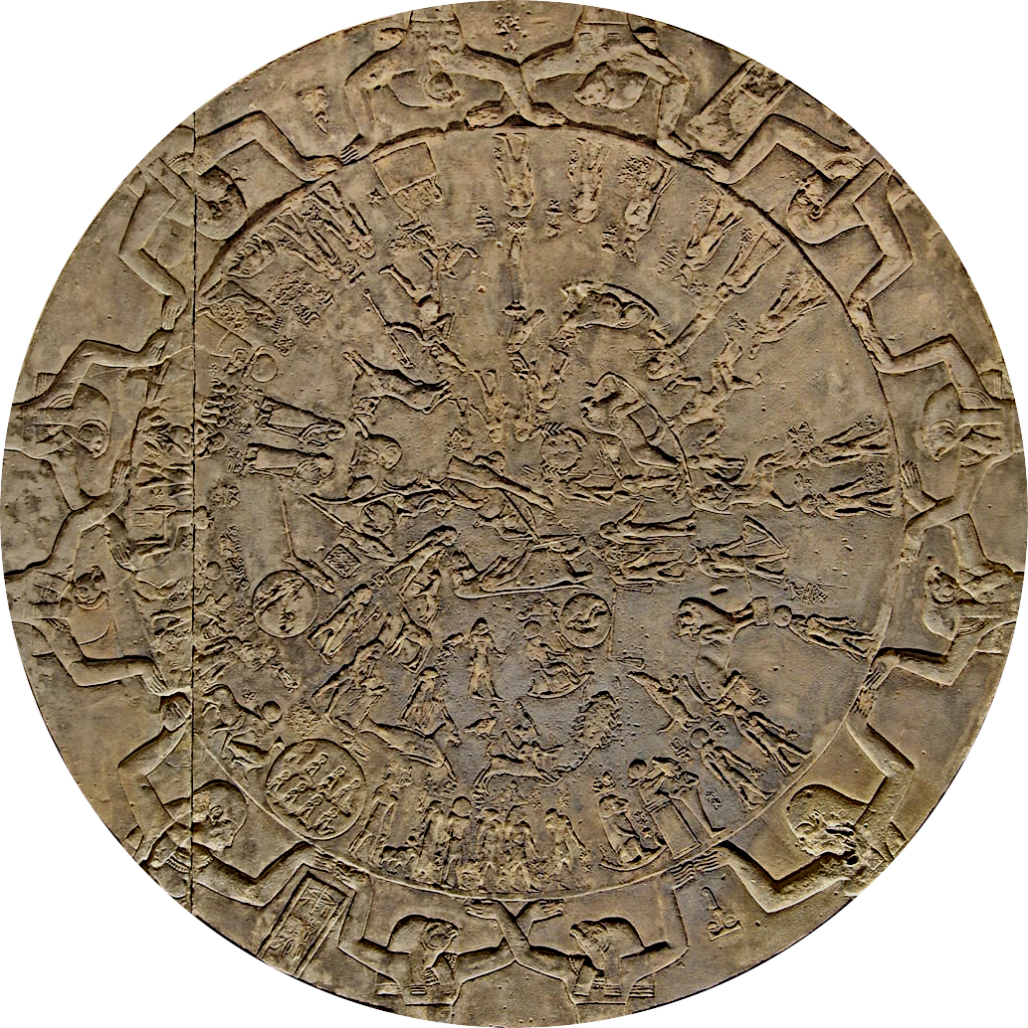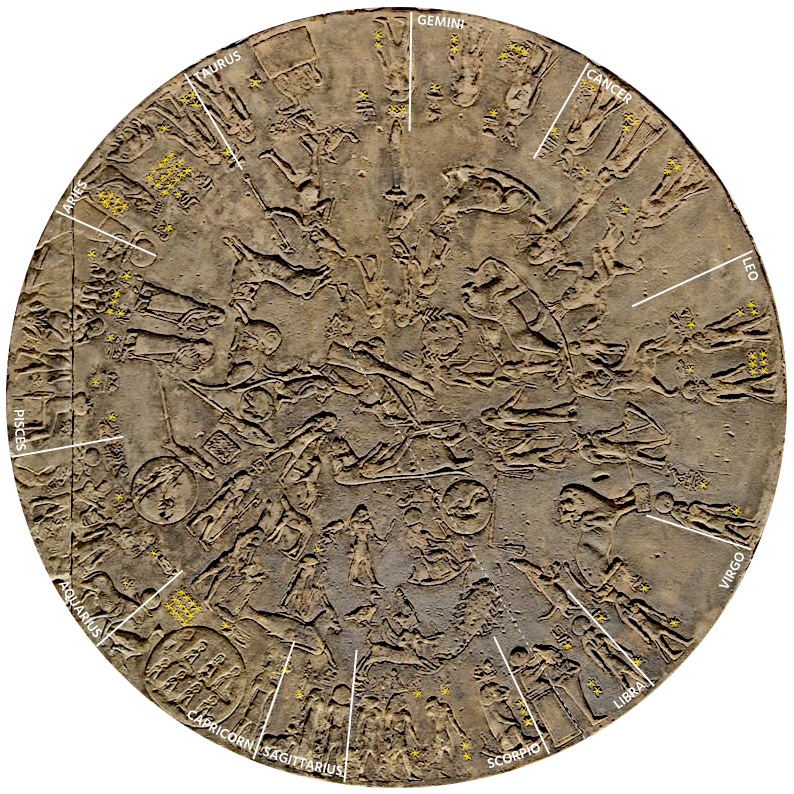The Dendera Zodiac
Jupiter
Page controls
This website animates the sculpture using the NASA DE441 and DE431 ephemerides, which contain the highly accurate positions of the solar system planets, as its data sources for the angular rotations that
are applied to the sculpture's component parts. This data is available in the right panel of this page in the 'technical data' tab. The animation can be reset at any time by clicking the button below and
the zodiac carvings on the inner circle of the sculpture can be viewed at any time by clicking on the other button.
(Click and hold)
This particular webpage, on the right side panel, explains the sculpture's Jupiter model and follows on from the previous page which explained the Mercury system.
It is advised to read that page before reading this one.
Jupiter carving

Explanation
Technical data
Jupiter
Zodiac sign Leo
The sculpture of the God that represent Jupiter has been identified through scholarly research and its identification is not under question. It is shown on the
left panel of this page in detail and is highlighted on the central circle of the main dynamic illustration.
The geometric alignment line of this God is shown on the left panel image by the yellow line. On the main image the dashed alignment line is shown coming from the top of the God's staff and at the point where this line intersects with the line coming from the principal alignment God's staff it is rotated clockwise by exactly 40 degrees. This angle does not follow the established logic of the previous planets but is a simple integer value and multiple of ten, in degrees. Because the principles of the rotations were clearly set out and identified in the three previous planets with Venus, Saturn and Mercury having angles of 88, 88 and 44 degrees respectively then there is no need to carry on the pattern. By this stage the puzzle solver will have worked out the rotation system.
A small image of Jupiter can now be added to the diagram in line with the 40 degree line and on the outer circular static frame of the carving, along with two white circles either side of the zodiac segment portion of the central carving to aid with clarity when looking at alignments.
On the illustration the dynamic model has already been aligned so that the principal God is pointing to the Vernal equinox at the top of the outer frame, but importantly the Zodiac outer section of the inner circle has not yet been rotated into position. However, unlike the previous planet carvings neither the God's staff nor the geometric reflection line align with any of the divisions of the zodiac on the outer part of the central circle.
The first step in the dynamic process of applying the astronomy is to align the zodiac portion of the inner circle to its correct position.
The geometric alignment line of this God is shown on the left panel image by the yellow line. On the main image the dashed alignment line is shown coming from the top of the God's staff and at the point where this line intersects with the line coming from the principal alignment God's staff it is rotated clockwise by exactly 40 degrees. This angle does not follow the established logic of the previous planets but is a simple integer value and multiple of ten, in degrees. Because the principles of the rotations were clearly set out and identified in the three previous planets with Venus, Saturn and Mercury having angles of 88, 88 and 44 degrees respectively then there is no need to carry on the pattern. By this stage the puzzle solver will have worked out the rotation system.
A small image of Jupiter can now be added to the diagram in line with the 40 degree line and on the outer circular static frame of the carving, along with two white circles either side of the zodiac segment portion of the central carving to aid with clarity when looking at alignments.
On the illustration the dynamic model has already been aligned so that the principal God is pointing to the Vernal equinox at the top of the outer frame, but importantly the Zodiac outer section of the inner circle has not yet been rotated into position. However, unlike the previous planet carvings neither the God's staff nor the geometric reflection line align with any of the divisions of the zodiac on the outer part of the central circle.
The first step in the dynamic process of applying the astronomy is to align the zodiac portion of the inner circle to its correct position.
When this is done the alignment line from the Jupiter God defines the location of the first point in the constellation of Leo as can be seen on the illustration.
The line also aligns with the center of the Leo carving on the central circle which can be checked by pressing the 'Show the zodiac carvings' on the left panel.
The first of the astronomy angles can now be applied to the dynamic illustration.
The first of the astronomy angles can now be applied to the dynamic illustration.
The second of the astronomy angles that defines the periapsis point is the next angle to be applied.
The true anomaly can finally be applied to Jupiter and the planet ends up in the winter solstice alignment circles correctly positioned as the fifth planet from the Sun.
The Jupiter system only defines one Zodiac section, whereas previous models have defined two such sections, and the reflection line has been set at 40 degrees which breaks
away from the logic pattern of the earlier planets. Clearly the systems in use are becoming more abstract, making them more difficult to solve and most importantly, impossible to solve unless
the previous planets logic has been identified.
The technical data from the NASA ephemerides that is used to perform the astronomy rotations along with technical notes regarding the rotations is listed in the technical data tab at the top of this panel.
Due to the logic used in the design the planets have to be solved in a particular order, the next of these being Uranus.
Click here to be taken to the Uranus page.
The technical data from the NASA ephemerides that is used to perform the astronomy rotations along with technical notes regarding the rotations is listed in the technical data tab at the top of this panel.
Due to the logic used in the design the planets have to be solved in a particular order, the next of these being Uranus.
Click here to be taken to the Uranus page.










